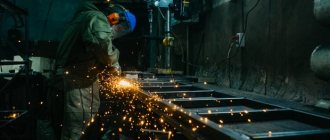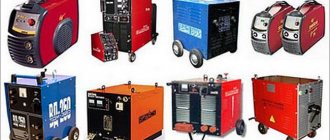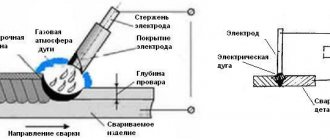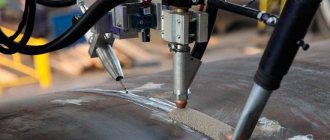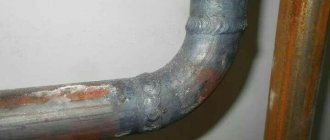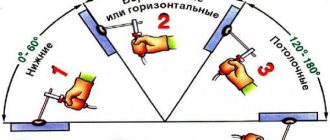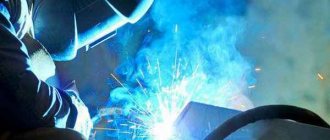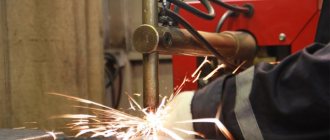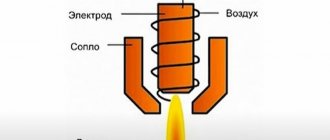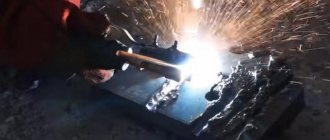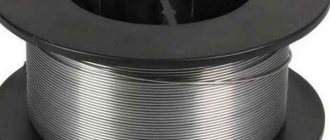Welding metal parts has been known to mankind for a long time. However, with the development of metallurgy, the emergence of new alloys and compounds, technology began to improve in order to meet all the requirements of emerging realities. Any novice welder needs to learn more information about TIG welding: what it is, how to use the equipment, what strengths and weaknesses it has.
TIG welding
What is TIG welding?
Before moving on to a description of the equipment and an analysis of the advantages and disadvantages, it is necessary to understand the principles of technology and the features of TIG welding. TIG welding is a method of joining metals that uses a tungsten electrode with a shielding gas. The rod is considered “non-melting”. The welder must sharpen it before use to ensure a stable arc and a straight weld.
The tungsten electrode is fixed in the torch in the center of the nozzle. At the edges of the burner there are holes through which protective gas is supplied. Argon is used for this. It protects the welding site from the formation of an oxide film. Additionally, filler wire must be used. It is desirable that it be made of the material that needs to be welded.
Types of welding machines depending on the type of welding
Having considered what types of welding machines there are by type of power source, let’s move on to their varieties according to welding modes.
Devices for manual arc welding MMA
These types of welding machines are built on the basis of inverters, transformers or rectifiers. The welder operates a holder on which the consumable electrode is fixed. The metal rod closes the arc on the workpiece and serves as a filler material. The outer coating, when melted, creates a gas cloud to protect the weld pool from the external environment.
Manual arc welding machine - MMA.
Application. This type of welding can join ferrous metals. If you install electrodes with a stainless steel rod, you will be able to weld alloy steel. But the speed of work is slow, you need enough experience to get a high-quality connection, and you constantly have to control the arc length as the electrode decreases.
Diagram of the electric arc welding process.
Watch a video about MMA welding machines:
Machines for semi-automatic MIG/MAG welding
MIG/MAG welding is called semi-automatic because the seam is made using a torch, but the wire inside is fed from a special mechanism from a reel. The principle of operation is similar to MMA, only instead of a holder there is a compact torch. The metal is connected by an electric arc (the ground cable is connected to the product, and the “plus” remains on the wire).
Semi-automatic welding machine - MIG/MAG.
Application. Thanks to the continuous supply of additive, long, neat seams can be created. There is no slag in the weld pool, so it is better for the welder to control it. Protection from the external environment is provided by gas supplied from the cylinder through the burner nozzle. This type of welding is fast and allows you to join metal with a thickness of 0.6 to 20.0 mm. Depending on the type of wire being installed, ferrous metal, stainless steel, and aluminum can be welded. But you need to carry a cylinder with you. Even when there is wind and work outside, the weld pool becomes defenseless (the supplied gas is blown away).
Diagram of the semi-automatic welding process.
Watch a video about semi-automatic MIG/MAG welding machines:
TIG welding machines
TIG welding is performed using inverters. There is also an electric arc here, but it burns between the product and a non-consumable tungsten electrode. The latter has a diameter of 1.6-3.2 mm and is sharpened in the form of a sharp cone. This allows you to create narrow seams. Connections can be made using only the edges being fused, or using an additionally supplied additive with the welder’s free hand. The weld pool is protected by argon blown from the torch nozzle.
Tig welding machine.
Application. When working with direct current, you can weld ferrous metals and stainless steel. There are types of welding machines with AC/DC function designed for welding aluminum. With such equipment you can cook very carefully and economically, but the speed of the method is significantly inferior to a semi-automatic one.
Scheme of the argon arc welding process.
Watch a video about welding machines for argon arc welding:
Universal welding machines
Universal models of welding machines combine several welding modes.
Here are the existing options:
- MMA+MIG. The model is capable of welding with coated electrodes and wire fed from the drum. In the first case, this is practical for cutting by electric welding, and in the second for serial production of sheet metal parts or body repairs.
- MIG+TIG. Semi-automatic with the possibility of connecting an argon burner. Allows you to quickly make seams on stainless steel and ferrous metal using the MIG mode, as well as join aluminum by switching to TIG.
- MMA+TIG. Inverter for welding with conventional electrodes and tungsten rods. Practical when alternating welding of ferrous and non-ferrous metals where high speed is not required.
- 3 in 1. The most versatile machines capable of welding in MMA, TIG and MIG modes. For this purpose, the front panel has several sockets for connecting the corresponding burners. Such equipment is purchased for a wide variety of tasks.
Spot welding machines
Spot welders come in models with pliers for double-sided welding or with a gun and reverse hammer for single-sided welding. The former are used for assembling thin-sheet structures (boxes, doors, gates, gates).
Device for spot welding on both sides.
The latter are used in body repair, when it is necessary to weld to a plane without access to the reverse side. There are manual portable models weighing up to 16 kg and stationary resistance welding machines. The thickness of the welded metal varies from 3 to 9 mm.
Single-sided spot welding machine.
Plasma welding machines
These types of devices use an electric arc burning in a nozzle between the cathode and anode. Compressed air from a compressor is passed through it, which forms plasma. Closing the mass on the product allows you to transfer the arc and make it not a duty arc, but a cutting arc. If you use filler wire, this method is suitable for welding parts.
Plasma welding machine.
Watch a video about plasma cutters:
History of appearance
Welding has been known to mankind for decades. The idea that it was possible to join metal parts under intense heat first appeared at the beginning of the 20th century. Charles L. Coffin, an American engineer, thought about creating such equipment. However, the first samples of equipment did not allow the device to be used in industrial conditions or to weld metal alloys.
A non-consumable tungsten electrode and a shielding gas (inert helium) were first tested in the 1940s. Using this technology, it was possible to combine aluminum, magnesium, and nickel. The method became popular in aircraft and rocket engineering, and then gained popularity among other areas of industry.
Description of the welding process
So, the whole process will combine the following actions:
- Cleaning the surfaces of each part.
- Installation of the bottom lining.
- Installation of parts on the lining.
- Setting the gap width, as well as fixing the parts motionless.
- Laying electrodes between parts.
- Installation of protective gasket, steel and copper lining.
- Starting the welding arc.
- Cooling and cleaning the weld seam.
To begin with, the electrodes should be installed in the holder, and then you can place them between the parts - this way the mass will be connected to the bottom lining. The maximum permissible length of a seam to be welded in one procedure will be 120 cm, because with a longer length premature overheating of the electrode residues occurs.
It is interesting that welding with a lying electrode is most often used to form straight seams, but it is allowed to bend the electrode according to the shape of the intended seam by no more than an angle of 30 degrees, because bending can lead to the coating starting to crumble and the electrode to break during welding . For the same reason, the use of several joining electrodes instead of a single long one is not allowed.
A paper pad between the copper pad and the parts is used to prevent premature wear of the pad, and it is worth making sure that the edges of the pad do not stick out, because they have the property of spontaneous combustion when welding, which can cause a fire.
You can start an arc in two ways at once:
- The second electrode, which is connected to the device.
- A piece of unnecessary metal.
If you are using a stationary type welding machine, then it is better to start the arc with the second electrode, which is installed in the holder, and it is very important that the holder is secured (the one in which the electrodes are clamped). The fact is that the attraction that occurs when an arc appears can pull the recumbent electrodes from under the gasket. To start an arc with a piece of metal, use a piece of material to connect the edge of the part that is being welded and the end of the electrode. Please note that during this process the piece of metal should be held in electrically insulating gloves.
Despite the fact that the welding arc will be hidden under the surface of the copper plate, the welder is required to use special eye protection because the arc radiation is always visible at the beginning and at the end of welding. Moreover, there is a high risk of the insufficiently heavy pad being thrown back when welding and opening the arc. You can place the metal for welding in the same plane or at different angles to each other, but in this case the gap between the parts is not established, and the overlay is adjusted to the shape of a truncated corner in the section.
Please note that loose flux can be used together with copper pads, and in this case the electrodes must be taken without coating. The use of flux for lying electrode welding makes it possible not to limit the length of the weld that will be formed in one procedure. Moreover, the uncoated electrode can be bent to a greater angle when welding parts with bends.
When you need to weld 3-4 parts at once around one main seam, the items should be arranged in this order:
- Place the largest piece down.
- The sides should have similar shaped parts.
- We place the lightest part on top of the electrode itself.
The upper part must completely cover the recumbent electrode and must be pressed with a load (usually bricks are used for this). To weld more than two parts at the same time, it is best to use a bundle of 3 or 7 electrodes.
Using a recumbent electrode, you can form not only joints, but even weld flat sheets of metal that overlap. To do this, the top cover should be made in the form of a longitudinal metal bar, in which a groove for the electrodes will be made. The overlay should be placed on sheets that are overlapped, with the groove with the electrode facing down, and the sheets will be melted through (provided that their thickness is up to 0.8 cm), or only the top sheet will melt completely (and the bottom sheet is very thick) .
Advantages and disadvantages
Any technological process has strengths and weaknesses. Advantages of argon TIG welding:
- Thanks to the use of protective gas, the seam is uniform, without pores, cracks, or voids. Argon protects the heated surface from the oxide film formed when hot metal interacts with oxygen.
- Internal stresses generated during welding without shielding gas are reduced.
- Metal does not splash.
- After welding, the products do not require additional processing.
- TIG welding can be used to join most known metals and alloys.
- It is enough to try to operate the equipment 2-3 times to master the skill of creating high-quality, beautiful seams.
Disadvantages of TIG welding:
- When using equipment outdoors, the connection point must be protected from the wind. Air flows disrupt the direction of movement of the protective gas, deteriorating the quality of the seam.
- It is necessary to carefully prepare the work surface.
- You cannot select an acute angle of inclination of the torch relative to the workpiece. This complicates the workflow.
- At the place where the electric arc ignites, a mark remains that will need to be cleaned off.
Considering the shortcomings of TIG equipment, you can prepare for possible difficulties during welding operation.
Beautiful weld seams
Application
Since TIG technology allows you to connect many metals and alloys based on them, it is used in various areas of industry:
- Automotive industry, manufacturing of parts for industrial equipment.
- Space industry.
- Construction of ships and airplanes.
- Manufacturing of medical instruments.
- Construction, creation of power tools.
TIG technology is often used at home. Using machines with tungsten electrodes, car body parts are welded and radiators are repaired.
Modes
TIG equipment operates using unipolar or alternating current. Each of the individual TIG welding modes is used for different materials.
TIG welding mode
D.C
Equipment operating on direct current has certain advantages. These include:
- The efficiency of the work process increases.
- You can weld parts to great depth. The seam is narrow, but deep.
- The speed of the welding process increases.
The minus is fed to the tungsten electrode, the plus goes to the workpiece. Equipment operating on direct current is suitable for joining alloy steels and stainless steel.
Alternating current
Equipment during operation of which there is an automatic change of minus and plus. As the reverse polarity increases, the surface is more effectively cleaned of the oxide film.
Gas cutting and welding machine
Gas welding involves heating the part until it melts with a high temperature flame . In this case, flammable gases are used - hydrogen, natural gas, acetylene. A distinctive property of these gases is their good combustion in air. Most often, acetylene is used in gas welding machines, which is easily obtained using calcium carbide and water. The combustion temperature of this gas is 3200–3400 °C.
Advantages of gas welding and metal cutting:
- Simple technology.
- No access to the electrical network is required, no need to use electric current.
- The equipment used for welding is quite simple.
It should be noted, however, that gas welding will not provide high speed and productivity, because it can only be done manually.
When gas welding, serious attention is paid to preparing parts, regulating the power of the torch, and installing it in the desired position.
Equipment
The welding process can be carried out with shielding gas and a non-consumable tungsten electrode using a conventional inverter with a torch that can supply gas. However, there are two types of specialized tools:
- TIG inverter. It is complemented by a block that can generate direct or alternating current. Thanks to this, the functionality of the device increases. Makes it possible to work with steels, aluminum, alloys.
- Welding rectifiers. The device converts alternating current into direct current. It is a professional device.
Equipment and consumables must be selected depending on what metal or alloy will be processed.
Inverter TIG welding
Algorithm for assembling a welding machine
After purchasing the installation, consumables, and connecting elements, you need to assemble the individual parts and mechanisms together. Assembly steps:
- Connect the oscillator to the inverter.
- Secure the wire responsible for ground to the terminal marked with a plus sign.
- The wire that is connected to the burner must be connected to the terminal with a minus sign.
- Attach the burner to the sleeve through which the gas flow will be conducted.
- Prepare an argon cylinder. Screw on the gearbox.
- Secure the gas supply hose to the reducer.
- Connect the inverter to a common network - 220 V. The oscillator must be powered from a power supply that produces 6 V.
To avoid mistakes when connecting elements, you can watch diagrams and training videos. After assembly, you need to configure the device. The quality of the work performed will depend on this.
Welding technique
The DIY welding process requires preliminary setup of the machine. To do this, the welder needs to perform a number of actions:
- When using non-consumable tungsten electrodes, they must be prepared in advance. The working rod must be sharpened using a needle file.
- After sharpening the electrode, it must be installed on the burner. A collet clamp is used for this.
- Open the valve on the argon cylinder. Using the reducer, set the operating gas flow rate. The optimal rate is 13 l/min.
- Fix the mass on the workpiece or metal work table.
- Turn on the oscillator. Bring the burner to the metal surface.
- After pressing the power button, a spark will appear. Open the gas supply to the burner.
The distance between the end of the electrode and the working surface must be at least 3 mm. You can guide the pointed part in different ways. If you increase the distance between the tungsten tip and the metal, the seam will become wide and the welding depth will decrease. When connecting thin workpieces, you need to move the torch from right to left. To make a root seam, you need to guide the electrode evenly. Corner joints are connected at an angle of 45 degrees.
TIG welding is used to join metals and metal-based alloys. The shielding gas used during the work prevents an oxide film from appearing. It is important to set up the equipment correctly, sharpen the non-consumable electrode before work, and keep the arc at the same distance from the workpiece.
Inverter Welding Basics
First, let's look at the design of the welding inverter. We won’t look at the “stuffing”; we’ll look at what’s on top and what we’ll have to use.
What does an inverter welding machine consist of? (To enlarge the picture size, right-click on it)
This device is a small metal box, which, depending on the power, weighs from 3 kg to 6-7 kg. The case is usually metal; some manufacturers make ventilation holes in it for better cooling of the “filling” (mostly the transformer). There is a belt for carrying, and sometimes there is also a handle: the belt is put on the shoulder if the work requires movement.
One of the panels has a power button or toggle switch. The front part contains power and overheat indicators. There are also knobs for setting voltage and welding current. Also on the front panel there are two outputs - “+” and “-” to which working cables are connected. One cable ends with a clothespin clip, which is attached to the part, the second - with an electrode holder. The power cable connector is usually located at the back. That's all, actually.
When purchasing an inverter, make sure that the cables are long enough and flexible: this makes it easier to work with. It is the insufficiently long and rigid working cables that have the most complaints from users of the popular brand of inverter welding machines “Resanta”.
The general principles of working with an inverter welding machine are described in this video.
Welding with an inverter for beginners
As with any electric welding, the melting of the metal occurs due to the heat of the electric arc. It occurs between the welding electrode and the metal being welded. To create an arc, they are connected to opposite poles: “+” is applied to one, “-” to the second.
When connecting the electrode to the “minus” and the part to the “plus”, the connection is called “direct”. If “plus” is applied to the electrode, the connection is reversed. Both options are used when welding, but only for metals of different thicknesses: reverse - for welding thin metals; straight - for welding thick metals (more than 3 mm thick). But this is not an immutable rule; sometimes they do the opposite.
Direct and reverse polarity of connection on the welding inverter
What causes this division in practice? Physics of the process. When an arc occurs, the electrodes move from minus to plus. And at the same time they transfer their energy to the positively charged surface, increasing its temperature. Therefore, the element that is connected to the positive output heats up more. When welding metals of sufficient thickness, they need to be heated well so that they melt and the weld is of high quality. That’s why they are given a “+”. Thin metal, on the contrary, can burn out due to overheating and a “minus” is attached to it, warming up the electrode more, from which more molten metal flows into the seam.
You can weld metal correctly with an inverter only if you have good control over the electrode. To do this, you need to take the holder correctly. How to do this, watch the video.
How a seam is formed during welding
To make the basics of welding with an inverter clearer, let’s look at what happens when a seam is formed. To begin with, let us clarify that a welding electrode for welding metals consists of a metal core and a coating - a special coating that protects the welding area from contact with oxygen contained in the air. Read more about electrodes for inverters here.
Now about the welding process itself. An electric arc is formed when the electrode core and metal come into contact (read how to ignite an arc below). At the same time, the coating begins to burn. It partially melts, turning into a liquid state, and partially turns into gases. These gases surround the welding zone - the weld pool. They prevent oxygen from the air from “breaking through” to the molten metal. The part of the coating that has become liquid covers the molten metal, creating a second layer of protection. After cooling, it turns into slag, which crusts over the seam. And at this stage, the slag protects the still hot metal from oxygen.
How does inverter welding work?
But slag and protection are far from the only process that occurs and that needs to be controlled. When welding, it is necessary to ensure that the junction of two pieces of metal is heated evenly and sufficiently. Both parts should melt to the same distance from the edge. To ensure uniform heating, you need to maintain the same distance from the tip of the electrode to the part. This is not very easy to do: the electrode melts during welding, and particles of its molten metal are transferred into the seam by the arc. Therefore, you have to gradually move the electrode holder closer to the part. But this is not the end of the electrode welding technique. You also need to “write out” some shapes with its tip - zigzags, circles, Christmas trees, etc. They allow you to make the seam wider and fuse two parts together. The most common electrode movements are shown in the photo below.
Electrode movements when welding with an inverter: for beginner welders, you need to practice several movements until they become automatic
That is, you need to move the electrode from side to side the width of the seam along one of these trajectories, while monitoring the state of the weld pool, and lower the electrode as it burns out, maintaining the distance to the part constant. This is the difficult task facing those who want to learn how to weld metal. It’s easier with a welding inverter - the arc is constant and doesn’t jump, but at first you may not succeed.
This video shows, in very slow motion, the transfer of metal particles from the electrode into the weld pool and how it is formed.
